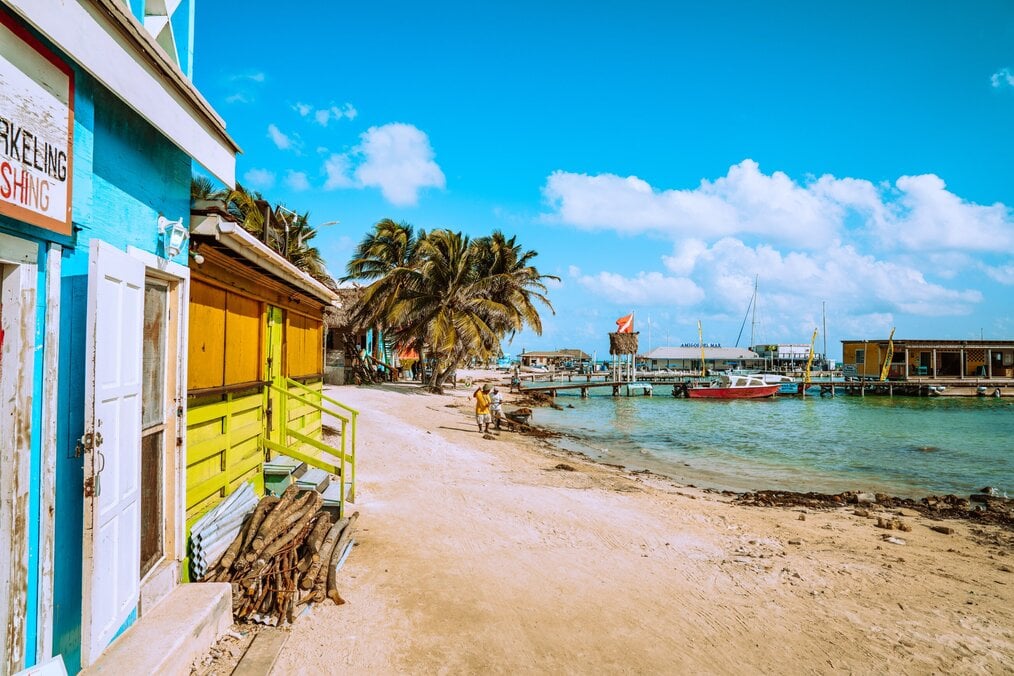How Much Does it Cost to Study Abroad in 2023?
Explore the costs of studying abroad in 2023, including low-cost and free destinations. Learn what to budget and where your money will go the farthest.
Studying abroad provides a whole host of benefits from expanding your worldview to gaining international experience, which will enhance both your resume and personal growth.
Aside from the enrichment of studying in a foreign country, it might also prove to be the more economical option. Research shows that after adjusting for inflation, the cost of public four-year university education in the US has tripled between 1989 and 2019. Direct enrollment at an overseas institution for a semester, year, or even an entire degree has the possibility to save you some substantial cash.
In this article, we’re featuring the cost of affordable and popular destinations to give you an idea of how to budget for your exciting study abroad adventure. We provide an overview of the average cost of living, tuition fees, and flight prices for each country in the hopes that by knowing what to expect financially, you’ll be one step closer to making your study abroad dreams a reality!
Direct enrollment vs. third-party providers

First things first — when studying abroad, you have two choices for enrollment: direct enrollment or a third-party provider. Simply put, these choices come down to price and the level of support you’ll be provided with.
Direct enrollment means you will be taking care of your application and transition to your new university on your own, much like you did for your home institution in the US. This option cuts out the middleman and usually results in cheaper tuition costs. Direct enrollment can also take the form of faculty-led or exchange study abroad programs through your home university. Through these arrangements, your university handles the registration and you pay either home tuition fees or a fee specific to the program you choose.
Third-party providers, while pricier, tend to arrange everything for you and usually include housing and insurance. You will be registered for classes and supported through visa applications and other travel and study arrangements.
It’s important to weigh the pros and cons of each. While direct enrollment could say you a ton on tuition, the cost of living in your country of choice could drive up the overall price tag. You will also need a significant level of independence to handle all of the planning required for direct enrollment such as applying for visas, registering for classes, and finding housing.
Costs associated with study abroad
Whether you choose to enroll directly at your foreign university or go with a third-party provider, you’ll have other costs associated with your study abroad. You’ll need to budget for several things that could begin to add up depending on the country you’re in. When doing your research, don’t forget to look into the monthly costs of the following:
- *Housing and utilities
- Local transportation
- Food and drink
- Incidentals (clothes and other supplies)
- Entertainment
- Books and materials
- Roundtrip airfare
- Passport and visa costs
*third-party providers usually provide housing in the overall program fee.
Want some help comparing costs? Try our handy cost comparison tool to see if you’ll save more money through direct enrollment or a third-party provider.
Study abroad costs by region

Historically, the most popular countries for study abroad tend to be localized in Western Europe. Students frequent this part of the world, making it familiar and accessible for prospective study abroad participants. However, if you step outside of Europe, you’ll find a literal world of choices, many of which offer quality education at an affordable price. Let’s take a look at a few regions across the globe to broaden your potential options.
Each country profile will include sample tuition costs, cost of living averages, and flight ticket estimates. These numbers are up-to-date but are intended to be used as a budgeting reference point. Your spending habits will determine how much extra money you should set aside, depending on whether you enjoy fancy dinners and frequent travel or cooking at home and thrifty shopping.
Study abroad in Africa

Although Africa is sometimes incorrectly referred to as if it were one destination, it is indeed a vast continent made up of 54 countries with distinct languages, cultures, and landscapes.
South Africa
An incredibly diverse country with 12 official languages, including English, South Africa has no shortage of exciting cultural opportunities for prospective students. This coupled with wildlife reserves and miles of coastline makes this gem of southern Africa an alluring destination. South Africa is home to several top international universities including the University of Cape Town, the University of Johannesburg, and Stellenbosch University.
- Average monthly cost of living (with rent): $900-$1,200
- Average cost of a semester (without housing) through direct enrollment: $2,000-$4,000
- Average cost of a semester (with housing) through third-party provider: $15,000-$19,500
- Average cost of roundtrip flight ticket from New York City to Cape Town: $800-$1,100
Ghana
Ghana is a West African country with a complex history that has as much to teach you outside of the classroom as it does in one. Ghana’s culture is a mix of influences from over 100 ethnic groups as well as from British colonial rule. Art is hugely important as evidenced by the beautiful kente cloth woven by the Asante and Ewe peoples — students interested in studying textiles, pottery, or wood carving will find endless inspiration in Ghana.
- Average monthly cost of living (with rent): $500-$700
- Average cost of a semester (without housing) through direct enrollment: $2,500-$3,500
- Average cost of a semester (with housing) through third-party provider: $18,500-$19,500
- Cost of roundtrip flight ticket from New York City to Accra: $1,200-$1,300
Study abroad in Asia

Asia is more than just a destination for language learning. Classes offered in English allow students to earn college credit while exploring local customs and culture outside of the classroom.
China
One of the world’s oldest civilizations, China is where ancient history meets modern-day innovation. Whether you’re a business student or simply a culture lover, you’ll find many exciting things to explore across this vast country.
- Average monthly cost of living (with rent): $850-$1,700
- Average cost of a semester (without housing) — direct enrollment: $2,000-$7,000
- Average cost of a semester (with housing) — third-party provider: $7,500-$12,000
- Average cost of roundtrip flight ticket from New York City to Beijing: $1,000-$1,300
To learn more about the in-depth costs associated with studying abroad in Italy, check out: How Much Does it Cost to Study Abroad in China?
Japan
Japan is home to fascinating history, healthy and delicious food, and a bustling pop culture scene that is sure to wow more than just die-hard Nintendo fans. This diverse island has something for everyone from art and architecture lovers to craft beer enthusiasts.
- Average monthly cost of living (with rent): $1,300-$2,200
- Average cost of a semester (without housing) — direct enrollment: $1,500-$2,500
- Average cost of a semester (with housing) — third-party provider: $20,000-$25,000
- Average cost of roundtrip flight ticket from New York City to Tokyo: $1,100-$1,300
To learn more about the in-depth costs associated with studying abroad in Italy, check out: How Much Does it Cost to Study Abroad in Japan?
Study abroad in Europe

By far the most popular region for study abroad students, Europe is a patchwork of languages and cultures that has a destination for every taste and budget. Golden beaches, snow-capped mountains, cosmopolitan cities, and charming villages — Europe as a region tops the study abroad list for a reason.
Italy
Foodies rejoice: Italy will give you the opportunity to experience the country’s rich culinary traditions alongside your studies. Enjoy art, culture, history, and the Mediterranean lifestyle during a semester abroad in Italy.
- Average monthly cost of living (with rent): $1,200-$1,600
- Average cost of a semester (without housing) through direct enrollment: $1,500-$6,000
- Average cost of a semester (with housing) through third-party provider: $15,000-$19,000
- Average cost of roundtrip flight ticket from New York City to Rome: $550-$750
To learn more about the in-depth costs associated with studying abroad in Italy, check out: How Much Does it Cost to Study Abroad in Italy?
Spain
Spain is consistently a top study abroad destination due to its gorgeous climate and relaxed pace of life. This popular country isn’t just for Spanish language students. Many programs offer courses in English for those just looking to experience the exciting culture and rich heritage.
- Average monthly cost of living (with rent): $1,100-$1,500
- Average cost of a semester (without housing) through direct enrollment: $1,500-$5,500
- Average cost of a semester (with housing) through a third-party provider: $10,500-$13,000
- Average cost of roundtrip flight ticket from New York City to Madrid: $550-$650
To learn more about the in-depth costs associated with studying abroad in Spain, check out: How Much Does it Cost to Study Abroad in Spain?
France
France is a great destination for French-language students and Francophiles alike. A country known for its food, wine, and cinema, there are plenty of cultural attractions to make your time in France both educational and memorable.
- Average monthly cost of living (with rent): $1,300-$1,900
- Average cost of a semester (without housing) through direct enrollment: $2,000-$7,000
- Average cost of a semester (with housing) through third-party provider: $12,000-$17,000
- Average cost of roundtrip flight ticket from New York City to Paris: $500-$700
To learn more about the in-depth costs associated with studying abroad in France, check out: How Much Does it Cost to Study Abroad in France?
Study abroad in Central America

Central America’s seven countries don’t top many study abroad lists but they should. Many destinations are politically stable and safe and are the perfect place to brush up on your Spanish with friendly and welcoming locals. From a purely practical view, the region is a stone’s throw from most US states making it a good first venture abroad for those who feel wary going to places as far-flung as Asia and Oceania.
Costa Rica
The land with the slogan of “Pura Vida“, or pure life, is sure to relax and rejuvenate you with its natural beauty and friendly locals. Costa Rica boasts pristine beaches, forests filled with wildlife, and vibrant cities and towns. Enjoy getting to know this small Central American country in between your studies during a semester abroad.
- Average monthly cost of living (with rent): $1,000-$1,300
- Average cost of a semester (without housing) through direct enrollment: $1,000-$3,000
- Average cost of a semester (with housing) through third-party provider: $8,500-$11,000
- Average cost of roundtrip flight ticket from New York City to San Jose: $400-$500
To learn more about the in-depth costs associated with studying abroad in Costa Rica, check out: How Much Does it Cost to Study Abroad in Costa Rica?
Belize
Nestled between Mexico and Guatemala, this tiny Central American country is easily missed. But if beaches, wildlife, and conservation studies are your thing, Belize is the perfect study abroad destination. English is an official language and is widely spoken along with Spanish and Belizean Creole so you’ll have the option to study a wide range of subjects in English or to brush up on your Spanish skills.
- Average monthly cost of living (with rent): $800-$1,250
- Average cost of a semester (without housing) through direct enrollment: $1,000-$3,000
- Average cost of a semester (with housing) through third-party provider: $18,000-$23,000
- Average cost of roundtrip flight ticket from New York City to Belize City: $450-$650
Study abroad in South America

The Amazon, the Andes, the Galapagos Islands, Machu Picchu: South America is filled to the brim with natural and manmade wonders. Here, you can improve your Spanish or Portuguese or choose to learn more about the many indigenous tribes found across the continent.
Argentina
Argentina brought us the tango, writers like Jorge Luis Borges, and great wine. Its cities, like the capital Buenos Aires, show off a distinctive European flair where you can experience all the art and culture the country has to offer.
- Average monthly cost of living (with rent): $550-$750
- Average cost of a semester (without housing) through direct enrollment: $200-$3,000
- Average cost of a semester (with housing) through third-party provider: $14,000-$17,500
- Average cost of roundtrip flight ticket from New York City to Buenos Aires: $1,000-$1,200
Brazil
Brazil is a country that knows how to have fun. The land of Carnival, samba, and caipirinhas is welcoming to students who want to embrace life’s simple pleasures. Brazilians are culturally diverse but the undercurrent of playfulness permeates throughout the population. If you want to study economic development, environmental and marine science, or Portuguese, Brazil should be your next study abroad stop.
- Average monthly cost of living (with rent): $700-$950
- Average cost of a semester (without housing) through direct enrollment: $1,000-$5,000
- Average cost of a semester (with housing) through third-party provider: $7,000-$19,000
- Average cost of roundtrip flight ticket from New York City to Sao Paulo: $900-$1,100
Study abroad in the Middle East

The Middle East region has been plagued with instability and turbulence in recent history but there are still countries that offer both safe and quality study abroad experiences.
Jordan
Jordan is home to over 100,000 tourist, religious, and archaeological sites making it a perfect study abroad destination for history and architecture lovers. Check out Petra, one of the seven wonders of the world, or float aimlessly in the Dead Sea while learning ancient history, archaeology, or Arabic in Jordan.
- Average monthly cost of living (with rent) : $800-$1,100
- Average cost of a semester (without housing) through direct enrollment: $500-$2,000
- Average cost of a semester (with housing) through third-party provider: $18,000-$20,000
- Average cost of roundtrip flight ticket from New York City to Amman: $500-$950
Israel
Even though Israel is commonly known for the Israeli-Palestinian conflict, it is more than a land marred by geopolitical and religious turmoil. Israel is home to holy sites for Jews, Muslims, and Christians alike and draws countless tourists every year to its historical and archaeological sites. While the country may appear unstable, it is indeed a safe destination for students wishing to study at its world-class universities.
- Average monthly cost of living (with rent) : $1,900-$2,800
- Average cost of a semester (without housing) through direct enrollment: $2,200-$8,500
- Average cost of a semester (with housing) through third-party provider: $11,000-$19,500
- Average cost of roundtrip flight ticket from New York City to Tel Aviv: $900-$1,100
Study abroad in Oceania

Getting to Oceania entails a lot of flight time but the trek is worth it. The island life awaits you in Australia and New Zealand as well as smaller destinations like Fiji, Papua New Guinea, and Tuvalu.
Australia
Those looking for ample opportunities to engage in outdoor activities while studying subjects like conservation and social justice will find their match in Australia. Australians enjoy an active lifestyle and its sprawling beaches and vast Outback make it easy to enjoy sport, camping, and surfing.
- Average monthly cost of living (with rent) : $1,800-$2,900
- Average cost of a semester (without housing) through direct enrollment: $10,000-$13,000
- Average cost of a semester (with housing) through third-party provider: $17,000-$23,500
- Average cost of roundtrip flight ticket from New York City to Sydney: $1,100-$1,600
To learn more about the in-depth costs associated with studying abroad in Australia, check out: How Much Does it Cost to Study Abroad in Australia?
New Zealand
Considered to be Australia’s best friend in the world by public poll, New Zealand has a sibling-like rivalry with their neighbor to the west. Although smaller than Australia, New Zealand offers stunning scenery from its spotless coastlines to its soaring mountains. Students who love the outdoors will find a fitting home away from home in New Zealand.
- Average monthly cost of living (with rent) : $1,650-$2,050
- Average cost of a semester (without housing) through direct enrollment: $8,000-$12,500
- Average cost of a semester (with housing) through third-party provider: $15,500-$21,000
- Average cost of roundtrip flight ticket from New York City to Christchurch: $1,950-$2,100
To learn more about the in-depth costs associated with studying abroad in New Zealand, check out: How Much Does it Cost to Study Abroad in New Zealand?
Study abroad for free: is it possible?

Believe it or not, some countries around the world provide post-secondary education free of charge to their citizens. So what about international students? Can they benefit from free university, too? Surprisingly, the answer is yes — but with a few caveats.
- Fees: while the degree program itself may be free, students will still need to pay fees. However, compared to the cost of a bachelor’s or master’s program in the US, you will be saving a bundle.
- Enrollment: in order to take advantage of the low price tag of overseas universities, students will need to enroll directly rather than using a third-party provider for their education.
- Language: countries with free university for international students do not have English as a native language. While many more universities are providing master’s degrees with instruction completely in English, you may have trouble finding full degrees at the bachelor’s level. However, if your plan is to only take a semester of classes, you’ll probably have less of an issue.
Where exactly can you study abroad for free or very low cost? Look to the following countries to start your search:
- Germany: fees per semester at public universities range between $100-$400 USD.
- Austria: students at public universities can expect to pay around $800 USD a semester in fees.
- Iceland: public universities do not charge tuition, but fees start from around $500 USD a year.
- Sweden: there are no tuition fees but it is estimated you’ll need around $800 USD a month to cover your living expenses.
- Norway: while public universities do not charge tuition, we should note that Norway is a notoriously expensive country to live in and students must show they have the funds to support themselves during their studies. Fees at public institutions start around $65.
Although many of these countries boast free tuition, their costs of living tend to be higher than in other countries. Weigh your options by considering both living and university costs to determine if studying abroad for free or cheap actually measures up.
Funding your study abroad
If the costs associated with study abroad seem overwhelming, just remember that your financial aid can be used to help cover costs outside of tuition and fees. There are also countless study abroad scholarships and grants to apply for in 2023.
Go Overseas loves to connect students with these opportunities. Details can be found in the following articles on our site:
- Go Overseas scholarships
- The Ultimate Guide to Study Abroad Need-Based Scholarships & Grants
- Study Abroad Scholarships for BIPOC Students
- 11 Secrets to Winning Study Abroad Scholarships
Fit studying abroad into your academic plan in 2023
I highly recommend fitting study abroad into your degree plan. As an undergraduate, I spent one month in Spain for a summer study abroad and the only thing I regret is that I didn’t stay longer.
As this article shows, spending a semester overseas is possible and well within your reach. With proper planning, you too can be on your way to one of these exciting countries and one of the best experiences of your life!
How to Travel Europe as a College Student
Who doesn’t dream of taking a big trip to Europe during college? Whether you’re looking to study abroad for a semester, head across the pond for a big summer trip or just take a winter or spring break vacay, there’s plenty of ways to see Europe for cheap. Between cheap destinations in Europe for students and budget tips for traveling in Europe, where to stay, how to find cheap flights and more, we’ve got the ultimate guide to how to travel Europe as a college student (on a budget!)
How to find cheap flights to Europe
If you’re searching for ways to travel to Europe for cheap, it all starts with finding a cheap plane ticket. Fortunately, there are lots of ways to get to Europe cheaply and without sacrificing leg room!

How far in advance to book flights to Europe?
The best time to book flights to Europe depends on when you want to go. A good rule of thumb is to book your flights at least six weeks in advance, but no more than 3-4 months ahead of time. If you’re visiting during winter break (especially over Christmas or New Years) or peak summer months (July and August), book your tickets a bit earlier. The best prices for winter flights are generally in September or early October. For summer flights, the best months to book are February or March.
Don’t care when you go, just want the cheapest flights? Book in December-February for travels in February or March. You’ll definitely find cheaper prices!
How much does it cost to fly to Europe?
Major European hubs often have cheaper flights than smaller, regional airports. The cost of flying to Europe also depends, of course, on where you’re flying from. If you’re traveling from the East Coast of the US to a major European hub, a good price is somewhere around $400 – $600. From the West Coast, a good price is around $500 – $700. If you’re flying into or out of a smaller hub, expect the price to be a bit higher.
Still seems too expensive? Don’t worry—you can get discounts on flights as a college student! Just sign up on StudentUniverse with your .edu email address, search for the flights you need from over 220+ airlines, and book with a discount. You can regularly find flights to Europe for $200-$400 if you’re a student!
Or check for promo codes before you purchase. You’ll find deals for specific airlines, destinations and more. For example, right now you can get an extra $30 off your flights to Europe if you fly LOT Polish Airlines.
Cheapest destinations in Europe for students
Traveling to big cities in Europe will be more expensive than visiting smaller, off-the-beaten path destinations. While Paris and Rome absolutely should be on your bucket list, we’ve got a ton more destinations that offer just as much charm at a fraction of the cost. If you’re traveling Europe as a college student, here’s five destinations that need to be on your list:
Warsaw

History-lovers, architecture-lovers, foodies and hipsters can all unite in Warsaw! Although often overlooked, Warsaw (the capital of Poland) is a great destination for anyone traveling Europe on a budget. Visit markets and gardens, get a feel for authentic local life, wander through Old Town with centuries of history or head to Praga, the hipster capital of Warsaw for modern art, restaurants, street art and more. The average daily cost to travel in Warsaw is only $40.
Budapest

Like other European cities, Budapest is home to cathedrals, castles, parks, historic districts and even thermal spas. Students will easily find relatively cheap accommodation, transportation and food options here. Even better? Many of the best things to see and do are free! Make sure to visit the Hungarian Parliament Building, Buda Castle and, of course, the Szechenyi Thermal Baths! The average daily cost to travel in Budapest is $42 a day.
Krakow

Krakow is the perfect place in Europe to visit if you’re on a budget, want to have an authentic experience AND want to immerse yourself in culture and history. From the medieval city center to the Old Town to the Jewish Quarter, there’s plenty to see and explore. Visit castles and cathedrals, enjoy wandering through beautiful town squares lined with shops and cafes, or have a tour through the underground salt mine. The average daily cost to travel in Krakow is $38.
Prague

If Prague isn’t on your bucket list yet, it’s time to add it! This budget-friendly city is one of our favorite places to visit in Europe as a college student (or anyone). From the iconic bridges and historic Old Town Square to the unique architecture ranging from the ancient (the 9th-century Prague castle) to the modern (Dancing House, anyone?), modern street art to parks and gardens, there’s plenty to explore. The average daily cost to travel in Prague is $50 a day.
Sofia, Bulgaria

Sofia is often overlooked among European cities, but it’s an incredible destination—and one that’s easily explored on a budget. With Persian, Slavic, Greek and Ottoman influences, there’s so much to experience all in one place. Not to mention that it’s home to over 2,000 years of history, from the ancient St. George Rotunda Church to the famous Alexander Nevsky Cathedral, there’s centuries of historical architecture, culture and traditions to explore. The average cost to travel in Sofia is $30 a day.
How to travel on a budget in Europe
Avoid tourist hot-spots in peak season. Prices will be MUCH more expensive, travel during off-season or visit more off-the-beaten-path destinations. You’ll save a lot of money AND have a more authentic experience, too! (Remember: for most places in Europe, peak season is July-August, as well as December.)
Shop during sales. Why pay full-price for flights when you don’t have to? Sign up for our emails and bookmark our promo code page so you’ll stay up-to-date on all the sales and deals. You can find discounts year-round to make your flights cheaper, whether you’re booking last-minute flights or planning ahead.
Find cheap accommodation. This is often the most expensive part of traveling, but there’s lots of ways to make it cheaper. Staying in hostels can save you a TON of money, and it’s a great way to meet like-minded travelers and new travel buddies! Airbnbs can also be a good option, especially in bigger cities.
Eat local. If you’re eating at fancy, sit-down restaurants for every meal, your budget is going to go out the window pretty quickly! Thankfully, there’s lots more options in Europe to eat cheaply. Check out local markets and cafes, get lunch at a street food stand, shop at local markets and grocery stores and make your own food and most of all, watch where the locals go! The small, unknown restaurants and cafes away from the touristed center of town are often much cheaper and just as delicious (if not more so!).
Get around Europe on a budget. Good news: there’s lots of cheap transportation options in Europe! If you’re staying in one city, use the local subway or bus systems to get around instead of renting a car or taking taxis. Or rent a bicycle or even a scooter if the city is on the smaller side!
Rail passes can be a good bet if you’re planning to take lots of long-distance trains in a short amount of time. For example, a 10-day Eurail travel pass costs € 301 ($349 USD). Many flights in Europe cost less than $50, so you may be better off flying between cheaper destinations and buying train tickets for more expensive ones. Long story short: do your research!
Red-eye flights and overnight trains are often a great way to save money when traveling Europe as a college student. Not only do you get a cheaper price (usually) for the route, but because your trip happens at night, you also save the cost of one night’s stay!
Ready to start planning your trip to Europe? Check out cheap flights to one of these cheap European destinations and fly LOT Polish Airlines to save even more on your next flight to Europe.
How to Travel in Europe on a Student Budget

Being an international student means more than just gaining knowledge through studies. It means experiencing culture shocks (one on arrival in the foreign country and another when you get back home), participating in various extracurricular activities, including traveling, and learning to survive on a tight student budget.
International students spend a lot on buying household goods, starting from a fork and plate, then ending up in a furniture store looking for a mattress. Once you’ve got all the basics covered, you might not think you can afford to splash out on any trips. But although traveling may be associated with unaffordable expenses, without weekend trips to neighboring cities or holidays in nearby countries, your university years risk becoming a little monotonous.
Europe is one of the places in the world where traveling seems common and even obligatory – the countries are so close together and the transportation so easy. However, for those who find European prices relatively high, it might be reasonable to bear in mind several tips on how to spend less, protect yourself from unpredicted bills and keep yourself from exhausting your student budget. Here’s my advice on how to travel in Europe without overspending…
 Travel in Europe with budget airlines
Travel in Europe with budget airlines
Planning your European trip one or two months ahead is the first way to leave more money in your bank account; the best deals on transport and accommodation are usually available for those who book early.
Since the early 90s European countries have been served by budget airlines, making travel in Europe that much easier and cheaper. Today these companies have grown and serve dozens of destinations. Three of the most widely known budget airlines are: British Easyjet (easyjet.com), Spanish Vueling (vueling.com) and Irish Ryanair (ryanair.com). The cheapest of these are Easyjet and Ryanair, where the lowest rate for one ticket may be just €17.
However, if using budget airlines, make sure you know exactly what you’ve paid for and what all the requirements are – otherwise you may have to pay unexpected extra fees. It might be worth knowing that Ryanair, for instance, requires online check-in. If you have carry-on luggage, every airline in the airport has their stands to check if your bag fits their standards. If your cabin bag is judged too large, you will have to pay around €50.
In my personal experience, I’ve found that Vueling and Easyjet work more professionally and offer better service. I’ve flown four times with Ryanair and every time something went wrong. In one example, we had to stand outside while waiting for boarding when the weather was cold. And overall, flying with Ryanair left me with more negative memories than neutral, especially when they made me pay for a cabin bag that suited their bag check desk… so from now on I’ll probably be choosing Vueling or Easyjet if I can.
Use technology to help you
Almost all budget airlines have made it more convenient for clients to check the available seats and the costs by creating downloadable apps for tablets and smartphones. In addition to using the apps created by the companies themselves, those on a student budget should also make use of comparison websites and apps to compare prices across all the possible options. Sometimes prices can range quite a lot, so that extra 15 minutes spent checking may save you enough for your next ticket.
 Travel Europe by train or plane?
Travel Europe by train or plane?
Another tip concerns the dilemma “Should I travel Europe by train or plane”? Train travel in Europe is often very easy and accessible; the websites of European train companies such as Spain’s Renfe, Portugal’s Comboios, Italy’s Italo and TrenItalia and Germany’s DB Bahn are reliable and user-friendly. Of course instead of taking the 11-hour train trip to get from Lisbon to Madrid, it is probably preferable to fly with Easyjet and reach the destination in 55 minutes.
If you want to travel Europe by train or plane, here are a few things to think about. When the distance can be easily covered by train, it might be more convenient and comfortable to take that option. The trains in Europe are fast, have more space inside than any budget airline’s cabin, and sometimes even offer facilities like wi-fi. In addition, train stations are mostly situated in the hearts of the cities, while airports are much further out. So by choosing the train you can save a lot of time – not only is there no long drive from city to airport, but you also don’t need to allow so much time to check in and go through security control. Plus, travelling by train is also better for the environment.
Of course, compared to many parts of the world, travel in Europe remains a pretty expensive undertaking. But if you’re spending some time studying in Europe, you should definitely take the chance to explore it as much as you can. So, good luck with savings and have the time of your life traveling!
Source https://www.gooverseas.com/blog/cost-to-study-abroad
Source https://www.studentuniverse.com/blog/destinations/europe/how-to-travel-europe-as-a-college-student
Source https://www.topuniversities.com/blog/how-travel-europe-student-budget